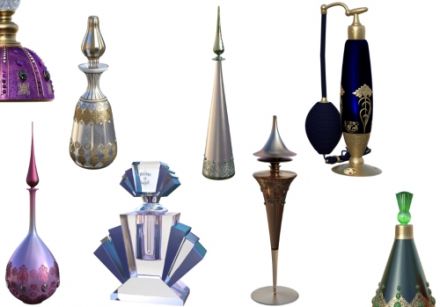The word perfume is from the Latin: per- through; and fumare, to smoke. Hence, a substance that affects agreeably the organs of smell, by giving forth a smoke or vapor generally invisible.
Early Use
Perfume was born in the Mediterranean region and its use was initially restricted to religious rites. The first perfumes were in the form of incense and was used to eliminate the odor of burning flesh arising from the sacrifices to the gods. Perfume flasks excavated in Babylon and Nineveh indicate that perfumes were well known at that time. But it soon became an integral part of the daily life of ordinary people in their bathing and beauty care habits as well as the preparations for their festivities...
Perfume is a trump card in the enticing game of seduction; it is an invitation for the senses to escape into a world of dreams.
Perfumes were known to ancient civilizations, which practiced the art of preparing magic blends with Jasmine from China, Roses from Ispahan, Cedarwood from Lebanon, Sandalwood, Olibanum, Myrrh, Patchouli and Vetiver...
In Egypt, make-up and perfumes were fashionable beauty accessories. In Arabia, the Queen of Sheba, who was attracted to King Salomon in all his glory, loaded her caravans for Jerusalem with hundreds of sweet smelling products.
During their huge banquets, the Greeks and Romans used to bathe doves and other birds in precious perfumes and then let them loose over the guests... a precursor of room fragrances!
When Mary Magdalene washed the foot of Christ, she dried them with her hair and anointed them with perfume ; to this day she is the patron saint of perfumers. In Carthage, it is laid that Salammbo wore two small golden amphoras around her ears, which let out droplets of an exquisite fragrance of wonderful essences specially blended for her. As for Cleopatra, she lived in the midst of perfumes and relied heavily on them to seduce Roman emperors.
During the Middle Ages, there was a fashion for perfumed leather. At the time, King Philippe Auguste granted glove makers the exclusive privilege to "prepare perfumes. creams and unguents...". For centuries, tanneries, which were Grasse's principal activity, used myrtle and lentisque powders to give their leather a green colour and exceptionally- fine quality.
With the Renaissance came the very popular vogue for perfumed gloves. Marie de Medicis is said to have owned more than 300 pairs. Towards the end of the 16th century, the tanners of Grasse therefore began to specialize in fine glove making by delicately scenting leather, gloves and doublets with fragrant oils and unguents.
In the course of the 18th century, scented glove-making gave away to Perfumery. The Tuberose, Jasmine, Orange Tree, Centifolia Rose, Violet, Mimosa and Jonquil were planted in the countryside around Grasse. Before the 1789 Revolution, it could be claimed that half of Europe extracts its essences from Grasse.




| Spas | Care & Make-up | Health | For Men | Glossaries | Various | |||||
| Intro | Face (care) Make-up Body Hair Endless Youth Mother & Baby Corner Suncare Essentials And more... New products Spot A HairdresserMake-up Artist Directory | Healthy Diet Watching your figure Relaxation | Intro New products | All about... | Phytotherapy All Natural Fashion Perfume Jewelry & accessories And more... What is your style? |
-

 Spas
Spas
-

 Care & Make-up
Care & Make-up
-

 Health
Health
-

 For Men
For Men
-

 Glossaries
Glossaries
-

 Various
Various








